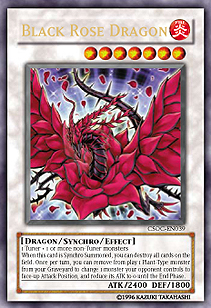 I wrote last week about the strength of prolonging the game, not because it’s something I think can work, but because it’s something I know can work. Since the release of Dark Armed Dragon there hasn’t really been a successful slow-paced deck. The release of Synchro monsters further enforced that trend. Since special summons are easily accessible and result in multiple 2500+ ATK monsters it seems obvious that playing out your cards is better than conserving them.
I wrote last week about the strength of prolonging the game, not because it’s something I think can work, but because it’s something I know can work. Since the release of Dark Armed Dragon there hasn’t really been a successful slow-paced deck. The release of Synchro monsters further enforced that trend. Since special summons are easily accessible and result in multiple 2500+ ATK monsters it seems obvious that playing out your cards is better than conserving them.
Now that very paragraph seems to contradict itself. The two best strategies are both to lengthen the game significantly and to play out all your cards. It seems like a paradox at first but it makes sense if you think about the second strategy first. Playing out all your cards is the best strategy because it results in 2500+ ATK monsters that can destroy things and protect themselves from destruction. That should let you win easily and quickly. In that case it’s definitely the best strategy.
But if you don’t win easily and quickly then your opponent was either able to match you and survive, or had a better hand and crushed you. In the second scenario, not playing your cards probably wouldn’t have won you the game anyway. I often see players make only one Synchro summon instead of two because they want to save their next Synchro monster for later. The idea is that by spreading out Synchros you can take care of problems on multiple turns and not have to worry about losing each Synchro. You know you have another one coming and that first one paid for itself by taking care of a problem.
That’s a good idea, but when your opponent has a better long-game hand your best shot is to trap him or her in a position where that player can’t outplay all your threats at once. Snipe Hunter, Breaker the Magical Warrior, Elemental Hero Stratos, Emergency Teleport, and Dark Armed Dragon can take care of most problems you present, but not all in one turn. If you’ve got a decent hand that can produce two Synchros supported by two copies of Phoenix Wing Wind Blast and the discards to pay for them, you could win that game in two turns. But if you tried to draw it out longer you’d lose.
Things don’t always work out as perfectly as that though. More often than not the game turns into an awkward top-decking war where both players try to make dead cards in their hands live. This is because the player with the stronger hand was forced to play it strangely in order to survive the weaker hand’s aggression. Instead of being able to win the game next turn, he or she had to play Dark Armed Dragon in main phase 2 just to stay in the game. Things like that create a weird top-decking game. The other thing that does that is the first scenario I listed for when you aren’t able to win with aggressive play. That’s where your opponent was able to match you and "cancel" answers, so that neither player was left with any leverage over the other. The same top-decking war takes place.
Coming out on top of top-decking wars is the difference between going x-3, x-2, and x-1. Ultimately, whether or not you make Day 2 is decided by one or two losses that were a result of bad top-decks in high-pressure situations. It’s how luck factors into the game. But if you know how to minimize the luck factor—say, by making your deck better in top-decking scenarios—then you could win almost every time. That’s the thought process that allowed Steven Harris to go two for two on Day 2 with this brilliant TeleDAD build:
Harris obviously built this deck with the knowledge that his opponents would want to play out all their cards. Many players have given up their third copy of Emergency Teleport for when they have to go into top-decking mode. At this point Teleport is usually a weak draw, and at times even dead because you’ve already drawn or special summoned your three copies of Krebons. Harris went a step further and dropped his third Krebons as well. There’s no need to worry about Teleport being live though because he’s replaced that Krebons with Psychic Commander.
 The Commander offers up a different top-decking strategy. Against decks that aren’t TeleDAD, battle is a possibility. The Commander can take down anything with 1900 ATK or less, making it a threat to both Lightsworn and Gladiator Beasts (especially during a top-deck war). But against TeleDAD the Commander’s biggest threat waits in the Synchro deck. Black Rose Dragon is the first Synchro monster that can destroy Colossal Fighter for good. That alone is enough reason to play Commander, but Black Rose offers up mass removal the likes of which we’ve never seen. It’s Dark Hole on steroids and all you have to do to make it happen is play one copy of Psychic Commander.
The Commander offers up a different top-decking strategy. Against decks that aren’t TeleDAD, battle is a possibility. The Commander can take down anything with 1900 ATK or less, making it a threat to both Lightsworn and Gladiator Beasts (especially during a top-deck war). But against TeleDAD the Commander’s biggest threat waits in the Synchro deck. Black Rose Dragon is the first Synchro monster that can destroy Colossal Fighter for good. That alone is enough reason to play Commander, but Black Rose offers up mass removal the likes of which we’ve never seen. It’s Dark Hole on steroids and all you have to do to make it happen is play one copy of Psychic Commander.
Most duelists tend to finish playing out their cards, leaving stuff on the field like Colossal Fighter, Dark Armed Dragon, or Crush Card Virus. Black Rose is outs to all of those. Often Dark Armed will be protected by the likes of Necro Gardna so you can’t run it over with a Synchro. Who needs to attack when you can just bomb the field? Similarly, players like to drop Thought Ruler Archfiend and Colossal Fighter when supported by Crush Card. The idea is that you can take care of opposing copies of Colossal Fighter or Dark Armed Dragon with Crush and from there your opponent will be unable to Wind Blast your Archfiend. Harris can just summon Armageddon Knight and play Emergency Teleport to clear both problems at once, losing none of those key cards to Crush Card.
Armageddon Knight was pivotal to Harris’ success. Whether you want to play out all your cards or play for a long game, Armageddon Knight is a great opening play. It can set you up for a turn-2 win or provide enough Synchro material for three Synchros all by itself. Also, when your draws dictate that you have to play awkwardly to live, it usually involves a Dark Grepher and some discards doing something like pitching Destiny Hero - Doom Lord to put a Malicious in your graveyard. Armageddon Knight allows you to continue playing smoothly, getting what you need into your graveyard without demanding a discard.
 The other thing Armageddon Knight can do is prevent your opponent from winning. Just by dropping Necro Gardna in your grave, you force your opponent to produce 8000 ATK without his or her biggest monster. Think about how perfect your hand needs to be in order to accomplish that. Now your opponent can’t OTK you: as the duel goes on he or she has to commit more and more answers to your cards instead of to your life points. Gardna’s protection becomes more and more secure.
The other thing Armageddon Knight can do is prevent your opponent from winning. Just by dropping Necro Gardna in your grave, you force your opponent to produce 8000 ATK without his or her biggest monster. Think about how perfect your hand needs to be in order to accomplish that. Now your opponent can’t OTK you: as the duel goes on he or she has to commit more and more answers to your cards instead of to your life points. Gardna’s protection becomes more and more secure.
You can’t lose unless your opponent has more answers than you do. This doesn’t work with Grepher because Grepher and the discard take up too many cards. You only have four left to your opponent’s six, and he or she can probably answer everything you’ve got. But with just Armageddon Knight you’re left with five cards to your opponent’s six even if the Knight is destroyed, and your odds of winning increase dramatically.
But that’s not the only card Harris included with the goal of living longer. Scapegoat and Gorz the Emissary of Darkness also help do that job. Scapegoat can stop almost any OTK while it’s happening: even Dark Armed usually can’t clear enough out of the way to win the game. The opponent can’t play his or her cards out successfully, and that’s a tremendous advantage provided by one card.
Finally Gorz helps on every possible front. He stops the OTK, provides a body your opponent has to deal with, is great during top-decking wars, and helps toward your own OTK next turn. Many players chose not to use Gorz because he counteracted their ability to play out all their cards. Steven Harris was able to play it because his deck can work successfully whether or not he plays out all his cards.
It’s unclear whether or not this build will take over the current carbon copy TeleDAD most players have been using. That deck has proven to be as versatile, consistent, and fast as any player could have dreamed. But has Harris provided a list that gives you even more? It definitely has an edge over other forms of TeleDAD, and I think we’ll see many Shonen Jump Champions in the future who have borrowed from Harris’s choices.
—Matt Peddle